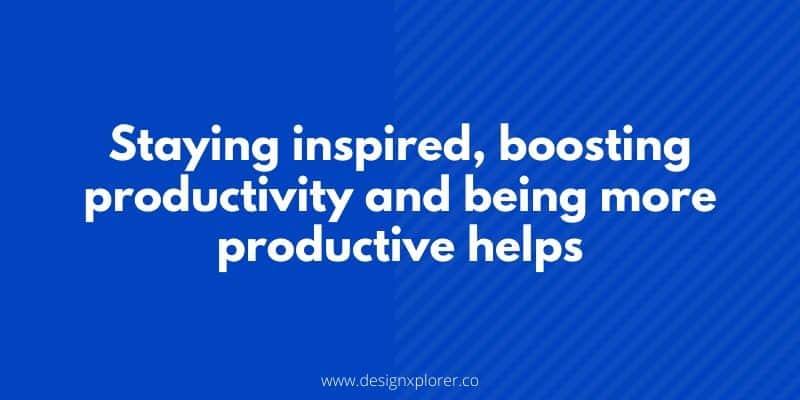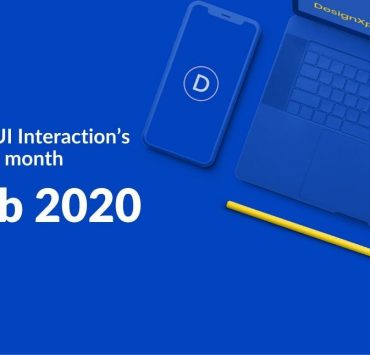
We are already a month into 2020, and it’s time you take your design skills to the next level if you want to stay competitive. To develop, grow and become the best possible designer you can be, in this article, we’ve touched upon the most crucial tips and strategies to inspire you:
- Why do you need to get inspired?
- Creativity and creative block
- When do you get creative blocks?
- How to handle a creative block?
- What makes a good designer
- How to become a better designer
- Tips on how to find and keep inspiration as a designer
- Staying inspired, boosting productivity and being more productive help
Why do you need to get inspired?

Web designing is a form of art that makes not just a designer but an artist. And like every artist, you need an inspiration to create art.
Inspiration is equivalent to motivation. You can’t do your job if you don’t feel motivated, right? And even if you do, it will feel forced and unnatural, leaving you with unsatisfied product in the process.
Motivation is scientifically proven to increase both creativity and productivity. So how do you get inspired?
Well… that’s up to you. Everybody is different in how they view the world and what makes them inspired.
An easy tip we can give you is to get inspiration through your favorite designers and idols. Look what they do, how they do it. Learn from them and try to create something new that resembles their work but in your own unique way. Doing this, you will not only get inspired, but you’ll also improve your skillset and design techniques.
Creativity and Creative Block

One of the best things that we, as humans, do is use our incredibly complicated brains to create. The human mind is full of potential and ability to improve that has been proven time and time again in our history. There is no limit to what we can create with our minds, and that is what ultimately makes us so unique.
Unfortunately, although we are capable of such incredible achievements, there is one major factor that sometimes stops our creativity is called a creative block.
Ironically the one thing that keeps our imaginative side to shine and to bear fruit comes from the same place that our creativity takes residence.
Check this article, if you want to know more about different types of creative blocks.
When do you get creative blocks?

Creative block is something we’ve all experienced. It’s our conscience doubt deep in our minds that tells us that we are not good enough or that our work is not good enough. Designers are sensitive to how their creations will be integrated, as well as the impact a solution may have on this earth; that is another reason why you may experience creative blocks.
Artists often are their worst critics. We won’t even start something until it’s perfect, creating a paradoxical loop in our heads restricting us from starting a project until it’s “blueprints” are perfect. Simply put we create these creative blocks out of fear that our work is not going to be so perfect as we want it to be… and that’s ok.
Creative blocks can also occur when you are exhausted from working for too long. In that case, you just have to get off that chair and take a break. It’s the same thing with studying, your brain isn’t a computer, and it needs time to “recharge” to function at 100%.
How to handle a creative block?

There are pretty effective ways to deal with the creative block that doesn’t involve psychiatrists.
Dealing with creative blocks can be hard and stressful, especially if you are on a tight schedule. Follow these guides, and you will be well equipped to get back on track with your work:
- Acknowledge that you are stuck in one and try to understand that it’s ok and that everyone has gotten through it.
- Always remind yourself that it’s ok not to be perfect, nothing really is perfect if you think about it. Everything has flowed, and you have to learn to embrace them to move forward and crush our mental and creative blocks.
- Even if you are not satisfied at first with what you’ve made initially, you can always go back and polish it, bringing new ideas, new ways to solve the problem. Often that problem doesn’t exist… well, it exists but only in our perfectionist’s minds.
And one more thing – give yourself a pep talk. Sometimes the biggest motivator is none-other but you alone. Every time you’ve finished an awesome work remember it that way when you feel like you are in a creative block again you can remind yourself that you are awesome and that you can do it because you are a great designer.
If you want to learn more on how to handle creative blocks, then visit this post on 20 ways to overcome creative block.
What makes a Good Designer?

Everyone wants to be the best at what they do, but maybe you should take a more realistic approach first in becoming a really good designer before going for the crown. But what makes a good designer?
Designers and mainly the good ones have traits that define them, making them amazing at what they do. Good designers are:
- Constantly evolving
Good designers are opportunists who give their all in design, constantly improves, and learns from better than them, but most importantly, they desire to change.
- Always improving
They are curious, they observe, take notice, and make notes of things others overlook; they have a desire to improve design standards.
- Problem solvers
Good designers seek out solutions to real problems and seek to make the world a better place. They know how to share their ideas and make them real.
- All about the context
Great designers understand the context. Context is what enables us to make sense of things. Context includes details that allow us to decide if something is relevant.
- Creative thinkers
Great designers are unbound by rules and think outside of the box. They understand social norms, expectations, and limitations of manufacturing, marketing, and other aspects of design implementation.
How to become a better designer

You are asking how to become a better designer, and we are answering with a couple of tips like:
- Be your own critic but in a good way
As we stated, earlier designers tend to be quite critical to their own work, unfortunately, most of the time, even more than necessary. Have an open mind, and look for mistakes that you can fix, but don’t be super obsessive about it.
A more healthy and nontoxic self constructive criticism is the way to do it. Look at the project and see it as if it wasn’t yours but rather someone else’s work that way, you’ll clearly see what works and what doesn’t.
- Seek feedback and constructive criticism
This one could be rather hard for those of you that don’t like to be criticized by others. But that fear of being rejected will only pull you back; you have to fight through that fear and let people help you.
Seek feedback from your friends in the design world or network to find and meet new ones. Having as much feedback from as many people as possible will be really beneficial for solving the problems you may currently struggle with.
Listen only to those that actually want to help you and give you an actual constructive criticism and ignore those who only find flaws after flaws in your work or you as a designer.
- Learn from other designers
People learn till they die. Even if you think you’ve reached the peak and view yourself as an absolute expert, you’re fooling yourself.
In a constantly changing and evolving sphere like web design where every day something gets updated and improved, you can never know enough, there will always be new things to learn, new ways to improve, and there will always be someone that knows something you don’t that can teach you.
- Get back to the basics
Everything gets to build upon a solid, concrete base. It’s impossible to start building in the air, that’s why it’s crucial always to get back to the fundamentals and even see something that you maybe have missed.
If you already have good knowledge and understanding of design theory, it’s not a bad idea to brush up on these topics occasionally. And if you have never devoted much time or effort to the basics, it’s never too late to get back to it.
We have a blog post that talks about Basics in Typography. Be sure to check it out. Back to Basics in Typography
- Follow a tutorial
There is no better source for grasping a new concept as a good old tutorial. Having thousands of helpful tutorials available online will give you the upper hand, and you’ll always be up to date with everything new in the design world.
Try these sites for the best tutorials on everything you will need to learn:
- Start a personal project
Learning the theory is one thing, but practicing it is something entirely different. You become twice as a better designer if you practice every new skill you learn. That is why we suggest you start a new personal project immediately after you have learned new something new in your field.
Trial and error will be your best friends that will teach you even better than a really good tutorial. Don’t be afraid to fail at doing something as long as you keep going at trying to do it better until eventually, you perfected it.
- Re-design for the fun of it
Doing personal projects is great for personal development, but going back to an old one and improving it by re-designing it is probably one of the best things you can do.
This is a perfect opportunity for you to look at your old design with fresh eyes and an open mind for constructive criticism… and, of course, to have a little fun doing so.
- Sign up for a class
Tutorials and practicing on your own are beneficial; that is an undoubted fact, but there is something even more effective, and that is signing up for a class.
There are plenty of online courses that could help you learn new skills and build upon the ones that you already have. If you could spare the time necessary to take a class, it will definitely be something worth exploring.
Having a person that will take time to personally help you or answer a question you have on the spot will save you the time and the effort to do it on your own.
Having an expert in the field on the spot can put you on the right path and guide your way through all the confusion and unnecessary struggle you would otherwise most likely confront in approaching this on your own.
- Get Inspired with Good Ted Talks
There are loads of good Ted Talks that can help you stay inspired and motivated. If you are struggling with motivation, then these videos can be of some help.
We have a blog post that talks on 3 Inspiring TED Talks – Three 20 mins Short Videos to Motivate You. Visit this post to learn more.
- Take photos
Photography is a relevant and quite helpful field for designers having a lot of commonalities with web design like composition and colors.
Taking up photography as a hobby is ideal because it can be fun and productive for your professional work as a designer regardless of how much or how little time you have available.
Not only taking photo’s is a fun activity, but it can also be a learning experience for designers. Critical elements & principles to good photography can also be applied to graphic and web design.
People often assume you need very expensive equipment in the form of super-high-resolution cameras, but that’s just a myth.
Simple point and shoot cameras will do for these purposes. If you enjoy it and you want to take it further, a more expensive camera can wind up being a good investment, but in the beginning, you don’t need to worry about that.
- Visit an art museum
Designing is a form of art, as we said in the beginning. And what is better place to enjoy art and get inspired than a museum.
If you can spare a day to visit one in your city, it would be great for your creative imagination to breathe and get a sense of something new and stimulating.
Tips on how to find and keep inspiration as a designer

Wanting to be inspired and being inspired is entirely two different things. Sometimes finding inspiration is very hard, and often filled with desperation, doubt, and all kinds of bad feelings.
Avoiding these feelings should be your top priority if you want to stay productive; that’s why we have yet another set of great tips for you to find and keep your inspiration like:
- Find a purpose
Greater meaning is the driving factor, and the overall ‘big picture’ everyone should live for.
Find something more important than you are and dedicate your life to it is the biggest motivation you could have. Remember, why did you become a designer, what dreams you had, what you wanted to accomplish.
Search deep in yourself what design means to you, why it is important to you, what you want to change in the world with your design. Ask yourself these questions every single day, and there will never be a day with a doubt in your mind and a day without inspiration.
- Engage with other designers
It’s important to meet and work with other artists; that way, everybody gets a different view and new perspectives that they might not have expected to exist.
Or even meet someone with a similar way of thinking like you and collaborate on a cause you both strive towards. Who knows, maybe you find a person that you admire and inspires you.
- Surround yourself with friends
Friends often are the best motivator for doing great things. Surround yourself with people that tell you to keep going and follow your dreams.
Allow them to be a part of the process, show them what you are working on currently, and they might have some ideas or advice to improve your design and even inspire you with something creative that you’ve not thought about.
- Visit design conference and learn how designers tackle creative challenges.
Meeting professionals within your domain industry help. You can share your problem and learn how other professionals approach creative blocks and inspirational challenges. I have listed a few top conferences around the world in one of my blog post. Make sure to check this out, if you plan to visit one.
17 Best Upcoming UX & Design Conferences in 2020
Staying inspired, boosting productivity and being more productive helps

At the end of the day, everybody has experienced good and bad days due to lack of inspiration. To reduce these days to a minimum and even better never have a day like that again, you should constantly be inspired and motivated.
Without inspiration, it’s not only difficult but almost impossible to do work on a broad level. Imagine starting a new project but without any motivation. Halfway through, you just give up before making any real progress. That’s why being inspired and having motivation is one of the most important things while designing.
When you are inspired, your productivity efficiency is at its finest. Not only while you are in that state, you work better, faster, and smarter, but you also feel great changing your mood from bored to excited which again boosts your productivity even more.
Being in the “zone” and being so productive will not only be beneficial to take a lot of work but also deliver good quality. The best projects are those when it is created with love and passion.
Final Thoughts
For some final thoughts, as usual, we’d like to wish you a great and motivated day, always be inspired even by the smallest things.
We hope that this article has inspired you to create great and amazing designs, just like you. Please let us know what you think about the topic, your opinion means a lot. Stay awesome, and stay tuned for more.





